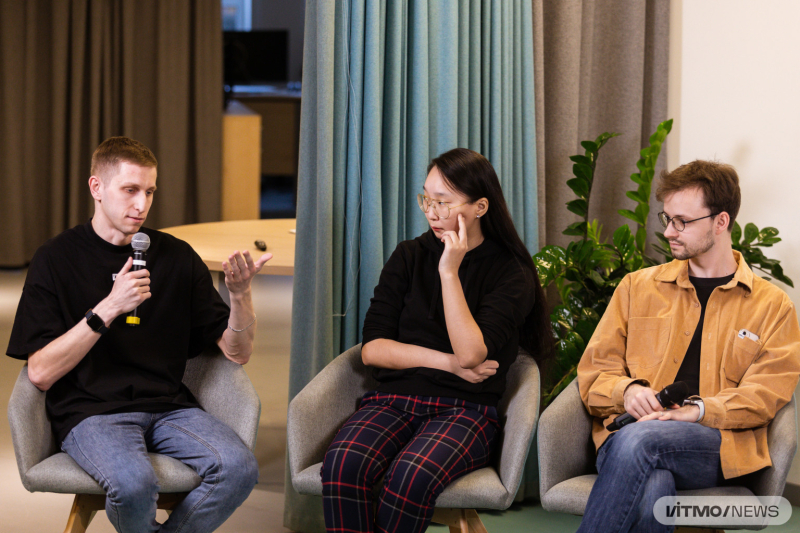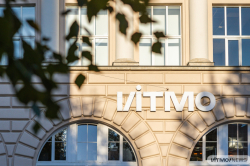Open call
In early March, ITMO University launched an open call inviting all ITMO students, graduates, and staff to share their ML – and in particular GPT – solutions for education, research, time management, and other fields. In total, the contest’s organizers received over 80 applications. The authors of the best projects presented their solutions at the ChatGPT meetup on March 28. Among the event’s keynote guests were Andrey Sebrant, the director for strategic marketing at Yandex; Alexandr Kapitonov, DSc, the dean of ITMO’s Faculty of Infocommunication Technologies; and Alexander Krainov, the director for development of AI technologies at Yandex.
A full livestream of the meeting is available here (in Russian).
Read also:
Yandex Director for AI: In a Year, ChatGPT Will Seem Mundane
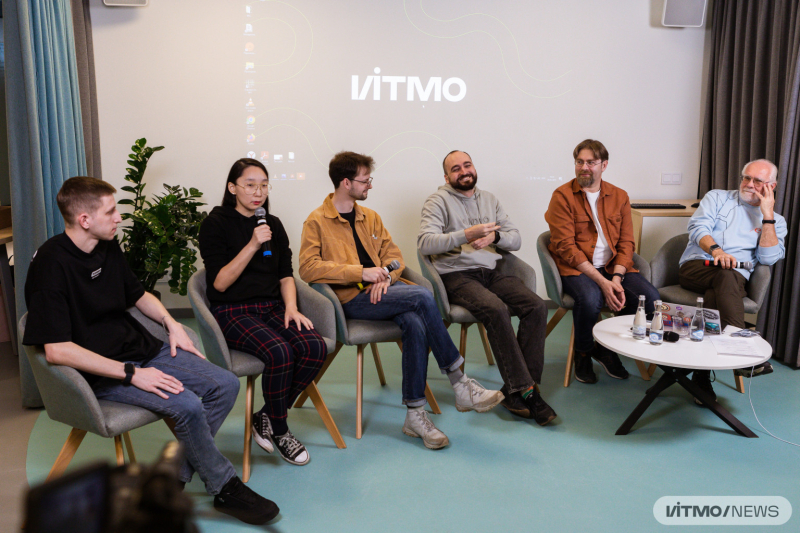
Speakers of the ChatGPT meetup. Photo by Dmitry Grigoryev / ITMO.NEWS
Teaching others
Gamification in marketing. A graduate of ITMO’s Faculty of Technological Management and Innovations, Vladimir Sologubov used ChatGPT to facilitate the learning process for students at Gameclub, a marketing-centric educational platform by Marketorium. Applying gamification in marketing can help tackle a vast array of internal and external tasks, from increasing sales and customer loyalty to boosting brand awareness and evoking certain emotions in the audience.
Jointly organized by Vladimir Sologubov and Daniil Baklamenko from the same faculty, the club includes mainly students and graduates of the Innovative Marketing Master’s program, yet its doors are open to everyone. Here, participants can ask the mentors’ advice on projects or tasks, as well as receive valuable feedback.
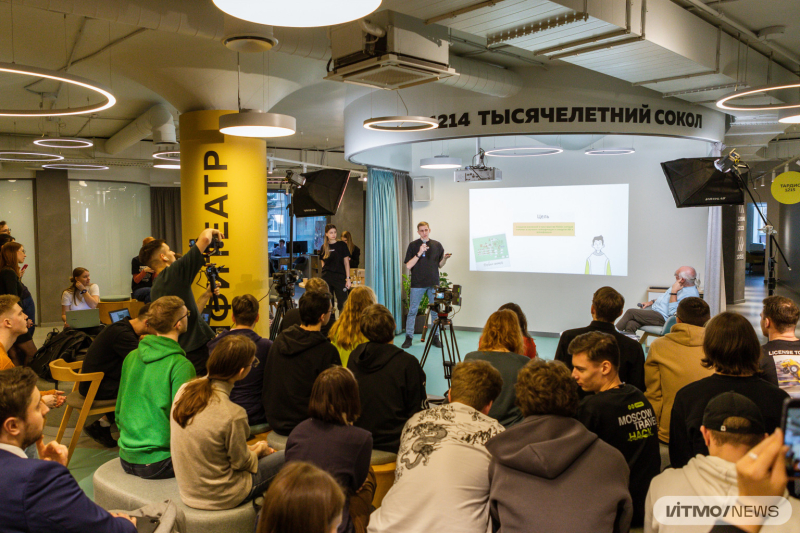
Vladimir Sologubov’s presentation at the ChatGPT meetup. Photo by Dmitry Grigoryev / ITMO.NEWS
The club’s meetings typically consist of two parts: first, the members discuss gamification via a Zoom call and then switch to Roblox to practice their knowledge on the topic by playing interactive games. As noted by Vladimir Sologubov, the most efficient way to study gamification is through first-hand experience, and that’s what Roblox is all about. The platform is user-friendly and greatly interactive, making it easier for users to immerse themselves in the plot of the game and, therefore, the learning process. Along the way, players figure out which game mechanics work best and which work the worst, as well as can compete with other players.
As users complete a task, they get access to new locations, along with NPCs that continue to unfold the storyline of the game. There are also side quests players can take part in to earn points that can be spent on customization.
How ChatGPT was used. As per rule, the game development process on Roblox can be boiled down to several stages: coding, script writing, and character design. To save time, the developers decided to turn to ChatGPT. Also with the help of the neural network Midjourney, Vladimir was able to generate images for a comic book that would help members stay on track if they’ve missed a club meeting.
“Earlier, we made a digital city on Miro, in which each player had their own character and house, and each location was about a certain topic. We enjoy it so much that this year, we decided to try to interact with AI on Roblox and thus find out how we can use it in gamification. We learned first-hand that ChatGPT can’t solve all the problems. Nevertheless, it is an excellent cure for blank page syndrome – but only if you know how to interact with it. To learn to do that, you need to get into the “head” of the machine. All in all, the bot helped us with half of our tasks but we had to edit everything it came up with anyway,” shares Vladimir Sologubov, a Master’s graduate from ITMO’s Faculty of Technological Management and Innovations.

Vladimir Sologubov. Photo by Dmitry Grigoryev / ITMO.NEWS
Thus, the developer asked the chatbot to write a script for a video game where characters from a fantasy world invite players to join simple field-related quests. His requests were as follows: “create a fantasy world, in which a team of players has to save the world from the villain named Рутина (“Routine” – Ed.) using gamification techniques”, “come up with 10 fantasy characters,” “make up a story about an innkeeper and his daughter for a fantasy video game”, or “create 10 gamification guests that NCPs will invite players to join in”. Vladimir used the online translator DeepL to communicate with the neural network.
The platform is still being improved. Even though the developers were able to use only 2 out of 10 quests and tasks proposed by ChatGPT, they are confident that it saves a lot of time and speeds up the content production process.
In the future, Vladimir Sologubov plans to continue working with neural networks, as well as implement 3D avatars made by the Avaturn neural network in his projects.
Read also:
We Made ChatGPT Explain Quantum Physics. Here Are the Results
Creating new products
A course on machine learning. A student of the Machine Learning Engineering Master’s program at the Institute of Applied Computer Science, Alexandra Cherk, is designing an online course titled Introduction to Machine Learning for the Ammosov North-Eastern Federal University’s educational portal. The course comprises a series of animated movies about AI. The making of a single video takes around a day, which involves writing the script, recording the voice-overs, and creating the visuals.
How ChatGPT was used. To speed up the development of the course, Alexandra Cherk collaborated with Egor Vasilyev, a student at the Faculty of Control Systems and Robotics, and applied neural networks to create an educational cartoon called What Is AI? ChatGPT assisted students in writing the script, producing the voice-over, and even describing some of the pictures used as backdrops for the movie. The authors then generated the visuals based on those descriptions using the neural network Midjourney. Consequently, the only thing left to do for the creators was to combine the script, visuals, and voice-overs in a video editing program.
The creators even used ChatGPT to produce the movie’s website: they asked the bot to write the code in HTML. After editing it a bit using special software, they had their website.
“Thanks to ChatGPT, we cut down on the time required to create a 2-3-minute short from a day to an hour. It also made designing websites a lot quicker and cheaper – we made ours for free. So far, we’ve only made a single short film with neural networks, but we plan to continue using them. Additionally, ChatGPT is also helpful when brainstorming or editing information,” shared Alexandra Cherk.
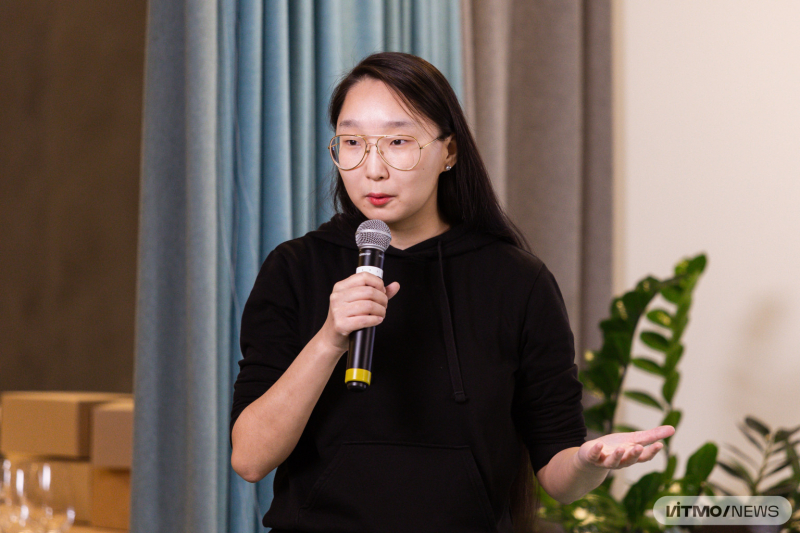
Alexandra Cherk. Photo by Dmitry Grigoryev / ITMO.NEWS
Read also:
Finding innovative solutions
Reinventing design. According to Valery Chernov, a graduate of HSE University’s School of Art and Design, designing new objects poses a significant problem: it is often not intuitively clear how to use them. For example, stick-shaped sugar packets are famous for this: they were designed to be opened in the middle, but lots of people do not know this and open them from the sides.
In order to create designs that are intuitive, Valery Chernov suggests using a computational approach. This means that neural networks are used to come up with shapes and forms by asking them to describe an object via text and then generating an image based on that text. Mini Dalle, MidJourney, Stable Diffusion, and other neural networks can be used for this purpose.
How ChatGPT was used. Valery Chernov ran a test by asking ChatGPT to design a chair that would accommodate a human with a dog. Based on the images from Midjourney, he created his own design for this chair.
“There are no universal methods to designing new objects, so artists and designers have to come up with their own ideas that they then have to advertise and sell. Lately, this led to a downturn as there are no new conceptual breakthroughs happening in the industry. That is why my colleagues and I started a Telegram channel about the problems of form design. When neural networks started becoming popular, we thought that they could be used to search for new solutions and put forth our approach to utilizing them,” said Valery Chernov.
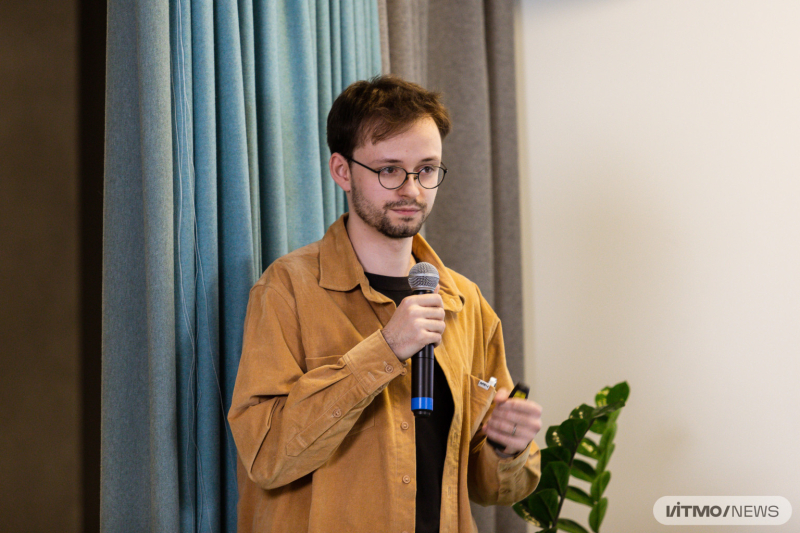
Valery Chernov. Photo by Dmitry Grigoryev / ITMO.NEWS
It should be noted that ChatGPT is already used for other tasks in design. They include picking color palettes, adjusting drawings to fit a certain style according to textual input, etc. Probably the most well-known example in Russian is the Nikolay Ironov 2.0 neural network developed by Art. Lebedev Studio. This network is capable of instantly generating unique logos for brands.
